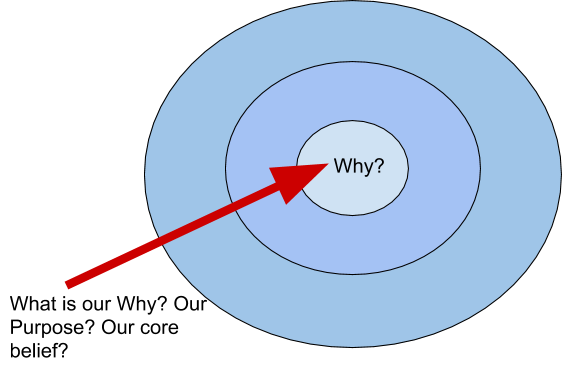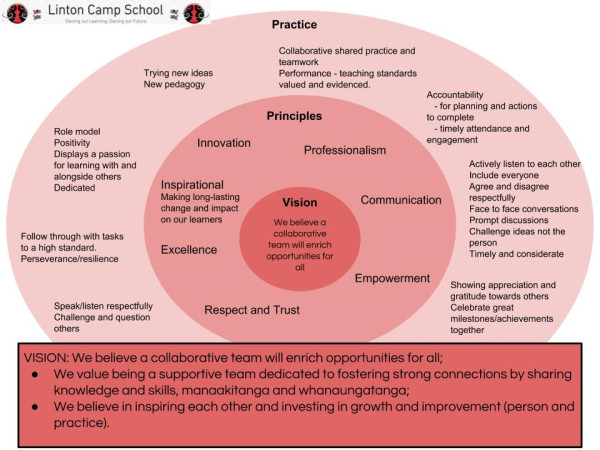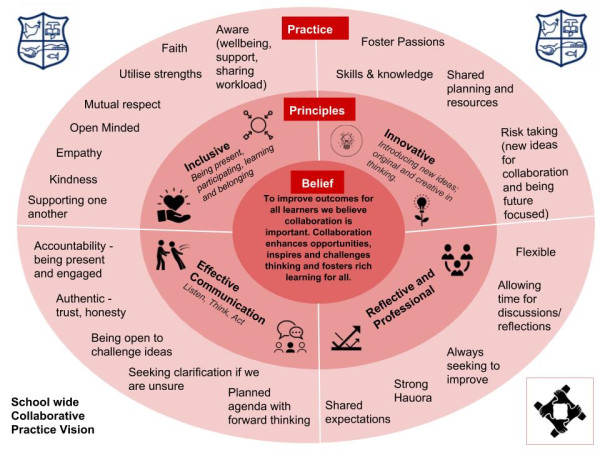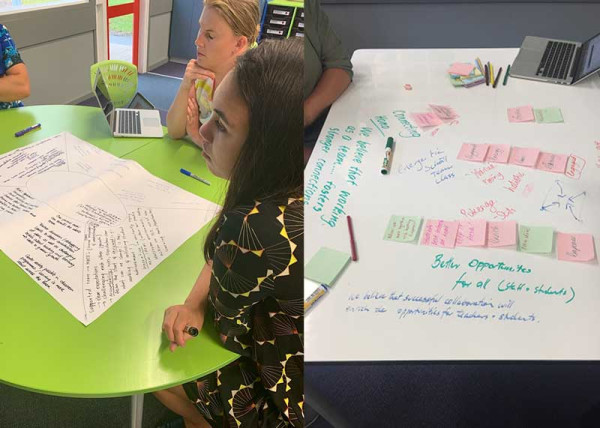Changing roles: A collaborative practice impact story
Where do we start?
If we understand what collaboration is and the impact this can have on ākonga (learners), and on our own teaching practice, we might be more likely to commit time and energy towards collaborative practices. This relates to the changing role of the teacher trend (CORE Education, 2019) and how we can harness the power of collaboration because as teachers, we work in increasingly complex and diverse settings. So what are the benefits or impacts collaborative teaching and learning practice provide for our learners, and for us as teachers? First we need to understand what it is and make sure we are clear about the difference between cooperation and collaboration.
“Collaboration refers to the capacity to work interdependently and synergistically in teams with strong interpersonal and team‐related skills including effective management of team dynamics, making substantive decisions together, and learning from and contributing to the learning of others.” Michael Fullan (2004)

Collaboration is about everyone creating and moving towards a shared goal that is greater than we would have been able to achieve independently. Through developing collaborative practice we can support building relational trust across teams. This is one of the many key drivers in the changing role of the teacher trend. Sometimes we think we are a collaborative team for example, when we say “we plan together”, but collaboration in this context goes beyond taking different areas of the curriculum and planning it. So what do we need to do to ensure that we are a high performing collaborative team that positively impacts learning for all ākonga?
Crafting our ‘Why’ or what we believe needs to be done together and mutually agreed upon is a good place to begin. Using a framework like Simon Sinek’s Golden Circle will help to clarify thinking.
The time taken to kōrero and explain our own thinking is an important part of collaborative learning because it enhances everyone’s understanding. Sinek’s Golden Circle is similar to Julia Atkin’s approach ‘From Values and Beliefs about Learning to Principles and Practice’. Why do we believe collaboration is important? If mutual belief is at the centre of what we do then it is easier to reflect on whether we are achieving what we value and believe, and allows us to ask if our belief matches our current state.

Linton Camp School has been focusing on collaborative practice for two years. Recently they were asked to think back to the beginning of the journey and what their initial thoughts and assumptions were about collaborative practice.
“Getting to the core of what collaboration was versus cooperation was eye opening and that helped me to focus my thinking when I thought about how our collaborative practice would look like. Also that collaborative practice meant more than just having shared goals and mutual respect, it’s about a high level of mutual trust, having vulnerability and a shared vision and shared values. When we worked together as a staff to develop a shared vision for collaborative practice it allowed us to generate new ideas as a team and agree on shared values that would be at the heart of our practice.” Ella Diprose (Junior Team Leader, Linton Camp School)
“Initially I assumed that collaboration was all about cutting holes in the wall and having to share a space with another teacher. I was worried about how that could clash with my style but I was pleasantly surprised by all the new learning and approaches that we could use to make it a truly collaborative practice.” Jamie Taylor (Bi-lingual Teacher, Linton Camp School)
The key part of the process is deciding together on ‘The Why’ (our belief), ‘The How’ (The principles that guide our belief) and ‘The What’ (action in practice) that will help your team to collaborate successful. This all helps to make explicit what you stand for and what gives direction to your actions in practice.
These examples from Linton Camp School and St Anthony’s School (Seatoun) show the outcomes from the process of developing a schoolwide collaborative vision. They look different, because they were developed authentically and collaboratively to suit the context. You can’t pick up what someone else is doing, this needs to be created from scratch so that has purpose and is meaningful


The next step was to take this even further. Teams within the school developed what Dalton & Anderson (2016) call a Team Charter. Some schools have named it an ‘Essential Agreement’ or a M.A.T.E’s (Mutually Agreed Team Expectations). This was an opportunity for teams to decide on and craft shared understandings about what they do as a team, and how they work and talk together. Suggestions for teams to craft shared understanding about from Dalton & Anderson (2016) include:
- Meetings (how these are run, agenda, purpose, chair, timing, how priorities are identified)
- Actions (accountability, responsibility)
- Communication (how are we respectfully honest and open, different perspectives, how we challenge ideas)
- Conflict (how we disagree respectfully, issue/person)
- Decision making (strategies for decision making, explanations, communicating the decision)
- Progress and celebration (how we celebrate, how we monitor and evaluate)
The impact of developing Team Charters:
“The MATES document has been amazing. Writing our expectations in clear language and being able to refer and refine it as things changed. This has flowed on into many other aspects of my life- my whānau, kōhanga and wider community projects. It really helps to set boundaries, expectations and build trust and respect.” Jamie Taylor (Bi-lingual Teacher, Linton Camp School)
“One of the biggest successes of collaboration is the growth in collaboration with our team which started from out MATEs agreement and has just grown from there. I believe our team is a supportive and collaborative unit.” Anna James (Senior Teacher, Linton Camp School)
“The MATES agreement work has really helped me as a leader now and into the future.” Warrick Price (Deputy Principal, Linton Camp School)

OK, now what?
The next challenge was transferring and applying the shared understandings to practice. How do we design learning experiences where students can develop social skills and relationships, collaborating with a range of different people and peers? Linton Camp School decided to focus on Maths as a team to start testing the waters out with collaborative practice, using their vision and team charter to help guide them. A flurry of exciting, innovative and creative ideas started flowing as they designed their collaborative team approach.

Left: Teachers trying out a collaborative learning design task (Dance Squad Challenge with Sphero) Right: Juniors science collaboration – learning about simple machines. These photos were of groups of 3 or 4 students working collaboratively to create an inclined plane car ramp.
“The ‘aha’ moment was definitely the Maths hub organisation. Working together to provide a high-quality maths programme using the principles of collaboration was excellent and has stood the test of time as we are willing to continually refine the processes.” Warrick Price (Deputy Principal, Linton Camp School)
“The Maths Hub has been a big change to our practice and we really have a sense of ‘our’ students as a senior team. I think the focus on collaboration with the students, moved them from cooperation.” Anna James (Senior Team Teacher, Linton Camp School)
“I would say there was a lot of ‘aha’ moments. The maths hub organisation was one of them and being able to develop our practice and learning systems for the students to bring greater success. I also loved having the MATEs agreement to have something to refer back to.” Kiri Parkinson (Senior Team Teacher, Linton Camp School)
The teachers used the CORE Education Collaboration Framework as a way to monitor and reflect on collaboration as a team. One of the five sides to the pentagon framework is ‘Challenge and Critique Practices for Transformation’. This helped to guide the conversations to debate and inquire into each others’ thinking.
The impact of working collaboratively
What has been the most effective approach/strategy that has supported your team to be collaborative and why?
“Our Maths Hub. The shared planning and regular discussion about effectiveness and tweaks required to ensure success. The focus is on student achievement and we are reliant upon all team members playing their part for success.” Anna James (Senior Team Teacher, Linton Camp School)
When you started to transfer collaborative practice into the classroom, how did your plans focus on capacity building and cultivating the expertise of every learner?
“As a team, we have purposefully planned for learning experiences that require students to take on specific roles that help the team to succeed. These structures are still being refined but I know we are onto a winner.” Warrick Price (Deputy Principal, Linton Camp School)
“When we began to bring our collaborative practice into our classrooms we worked to model collaboration first amongst us teachers in front of the students in our science focus in Term 2 as for example we would model in writing. The students enjoyed seeing the teachers working together and it was a great opportunity to practise working collaboratively.” Ella Diprose (Junior Team Leader, Linton Camp School)
“We were open with the students about the teachers learning to be more collaborative in our practice. I shared with them the journey we were on and talked about how the Maths Hub and our communication unit (Podcasting, Audio Books, Stop Motion) were ideas that have come about from our work. We used strategies such as students building MATEs agreements, role assigning and building success criteria and matrices to support the learners.” Anna James (Senior Team Teacher, Linton Camp School)
“Modelling collaboration by the teachers and using hands-on activities to engage them. We showed different types of learners and also modelled what wasn’t collaboration.” Hanna Bills (Junior Team Teachers, Linton Camp School)
“Having students having specific roles that were clear and defined to them. Modelling collaboration and using it a lot in our regular teaching vocab to build students’ understanding.” Kiri Parkinson (Senior Team Teacher, Linton School Camp)
What impact has the collaboration vision, principles and practices had on learners and how do you know?
Linton Camp School teachers identified once they took collective responsibility for the progress of all learners they found there was improved learning and achievement in the Maths area (this was the focus for their pilot) and higher level thinking skills. Learners expressed satisfaction with the learning experience. The teachers had a deep understanding of collaboration within their teaching team which supported them to effectively model the skills with students. It also allowed the teachers and students to be creative with how they use their spaces which impacted engaging in increased professional conversations about all students, the approach and feedback on their own teaching.
“There has been an obvious impact on the students as the vast majority of the PLD we did has become commonplace within the senior team learning systems. The links with the 21st century skills has been an obvious match for collaborative practice and we are as a result structuring more and more learning areas to reflect collaborative systems.” Warrick Price (Deputy Principal, Linton Camp School)
The collaborative practice approach also led to improved empathy skills, social interaction skills, self-management skills and opportunities to develop leadership skills. The list can be extensive when highlighting and identifying the impacts and effects of collaborative practice. One of the biggest benefits is the opportunities it allows for improved dialogue (with all learners) and communication skills.
“This is one of the most motivating and engaging PLDs I have ever been involved in. If I am enthusiastic then this rubs onto the students. I believe our students are more aware of the 21st century skills and the importance of these for them. We are planning for a lot more collaborative activities and systems. As a result the students are working more collaboratively and definitely improving in this area.” Anna James (Senior Teachers, Linton Camp School
“Collaborative learning aims to promote dialogue. Dialogue enhances understanding when learners explain to each other. As learners become more adept in talking themselves through problems and contexts, their ‘outer speech’ develops, and so does their ‘inner speech’, giving greater power of self-direction.” -Watkins (2009)
It is important to allow opportunities to review the experiences of collaborative learning with your students and your team.This helps to grow assessment capabilities with students so they can articulate their thinking about their learning. A few key questions could be:
- What helps our group/team work best?
- How was our communication? (how we talked together, equal chance to talk, managing disagreements)
- Next time, what would we like to improve?
A final thought from Linton Camp School teachers…
“We have proven that single cell spaces can still have great collaboration happening in them. Developing systems that promote collaboration between students is important and it relies on understanding what collaboration is and designing tasks that help students to improve their skills.”
References
Atkin, J. (1996). From Values and Beliefs about Learning to Principles and Practice. Harden-Murrumburrah.
CORE Education. (2019). Changing role of teachers » CORE Education. Retrieved 6 November 2019, f
CORE Education. (2019). Collaboration Framework » CORE Education. Retrieved 6 November 2019,
Dalton, J., & Anderson, D. (2016). Learning talk: Important conversations at work, Volume 5. Hands On Educational Consultancy Pty Limited.
Fullan, M., & Scott, G. (2014). Education PLUS [Ebook]. Seattle: Collaborative Impact SPC.
Grow Waitaha. (2019). Shirley Primary School – Using team charters for collaborative practice. Retrieved 6 November 2019, from
Watkins, C. (2009). Co-operation vs collaboration. School Leadership Today, 1(1), 22-25.
Explore more content
Explore our wide range of education related podcasts and blogs, ranging from experts discussing Kaupapa Māori, Cultural capability and te reo Māori, Leadership, Pacific viewpoints, Digital and innovation, Inclusive learning and more.